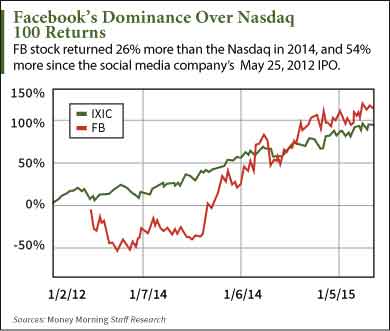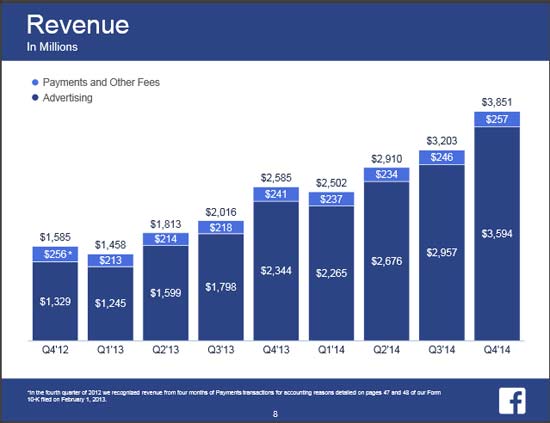Facebook stock (Nasdaq: FB) crushed Nasdaq 100 returns by 26.79% last year, and by 54% since it went public in May 2012.
To understand what's fueled this rise, we answered a key question: "How does Facebook make money?"
Those in the advertising industry have known for a long time...
 We asked Money Morning E-commerce Director Bret Holmes to shed some light on how Facebook is making money. Holmes uses web advertising across multiple social media platforms as part of his job here at Money Morning. And with Facebook's 1.39 billion monthly active users (and 1.19 billion on mobile) - more than any other social media site - its advertising model is a key component of his work.
We asked Money Morning E-commerce Director Bret Holmes to shed some light on how Facebook is making money. Holmes uses web advertising across multiple social media platforms as part of his job here at Money Morning. And with Facebook's 1.39 billion monthly active users (and 1.19 billion on mobile) - more than any other social media site - its advertising model is a key component of his work.
"Social media companies are legitimate advertising websites, no different than, say, Google (Nasdaq: GOOG, GOOGL) or Yahoo (Nasdaq: YHOO)," Holmes said. "Except users have a much different relationship with Facebook. FB functions like a family - it knows a lot about you, you're constantly interacting. Google is more like your neighborhood - it's there when you need it, but you don't need it every day."
The trick for social media companies like Facebook profiting as ad platforms is finding the best way to insert advertising into this "family-like" user experience without impacting the user in a negative way.
And that's a trick Facebook figured out in 2013...
How Does Facebook Make Money? It's All About the Advertising
We all remember that Facebook's 2012 IPO was an unmitigated disaster. It lost over half of its value within six months of listing, and was priced at 107 times trailing 12-month earnings, making it pricier than 99% of all companies in the S&P 500 at the time.
But its rebound - the Facebook stock price more than doubled from July through September 2013 - stemmed from advertising.
"Facebook has gotten really good at advertising. It's inexpensive and it's smartly done," Holmes said. Facebook has made two changes to unlock its value and become what Holmes described as "the most advantageously competitive product on the market for advertisers, hands down."
The first thing it did to turn performance around was develop a new advertising format in early 2013.
You see, Facebook originally started with space ads. Then, it gave advertisers the ability to promote an individual's or a company's Facebook page. But things were still sluggish.
The new format it implemented is technically referred to as "native social ads" - ads that are seamlessly integrated into the social media's platform. BIA/Kelsey projects social media native revenue as the fastest-growing social media advertising method at a 38.6% CAGR by 2018.
"Facebook has integrated in-stream ads to the user experience. Response rates are high and advertisers will always chase the least expensive ad with the best response," said Holmes.
In-stream ads can be videos. For instance, a commercial will appear before the user may watch an Internet video. On a social media site like Facebook, which has real-time update feeds, in-stream ads can be inserted into a streaming feed. So, for example, the user scrolls through the news feed to see what friends and family are up to, and in-stream ads are peppered into the feed.
"For the first time, in 2013, Facebook let advertisers access FBX, an ad exchange where you can customize your own ads," explained Holmes. "Now we can glean information and better target our audience. We can also advertise on mobile now."
Advertisers began flocking to the site. Now, the company has more than 1.5 million working within it, fueling literally billions in revenue. FB reported on Jan. 28, 2015, that it raked in $11,492 million in ad revenue alone the year before:
 This is just the beginning of how much money Facebook can make...
This is just the beginning of how much money Facebook can make...
In February 2015, Econsultancy data showed 71% of companies said they would increase their digital marketing budgets in this year, by an average of 27%. And SocialFresh, another research firm, reported social marketing budgets will double over the next five years.
Facebook made a big move on Sept. 29, 2014, that shows it's setting up to take full advantage of the digital advertising trend.
The company launched a new platform that's going to revolutionize web advertising - and "it's going to make Facebook an absolute juggernaut"...
Facebook's Revolutionary "Atlas" Revamp
In the revenue chart above, you'll note a big ad revenue jump in Q4 2014. In that quarter, FB announced it rebuilt its "Atlas" ad platform and released it for beta testing.
Before the new Atlas, the company used cookies to track what websites you visit, and then it would serve users targeted ads on its site. The revamped version allows tracking on mobile - making available huge datasets that weren't accessible before. It also gives advertisers feedback (like what percent bought a product based on a certain ad that ran on Facebook).
[epom key="ddec3ef33420ef7c9964a4695c349764" redirect="" sourceid="" imported="false"]
But really, the new Atlas is a big deal because it delivers people-based marketing instead of content-based marketing. What that means - and why it's so revolutionary - is best explained by comparison.
Take Google. The company uses two things to serve people targeted ads: content and search history. While your web page content and the searches you're inputting are good resources to serve targeted ads, it pales in comparison to the personal data Facebook takes into account.
"For Google ad targeting, it's sort of like trying to define you by the letters you receive in the mail - your L.L. Bean catalogs and whatnot," Holmes said. "But for Facebook ad targeting, it's more like interviewing your grandparents, your friends, the restaurants you eat in - all of your daily activities."
It's also tapping into mobile. If you use Facebook to log into apps (think Instagram, Pinterest, and Foursquare, to name a few) all that data is game too.
Of course, the better the targeting, the more effective the ads.
"Now imagine you're going to that shopping mall, but it already knows the exact three stores you need and when you get there, those are the three up front. That's how the new Atlas works," Holmes said.
And that's why Atlas is a game changer for web advertising - and for how Facebook makes money.
Follow me on Twitter @TaraKateClarke.
Cash in on Tech Stocks in 2015: All the ingredients are now present for a multiyear run in tech stocks that will dwarf anything we've seen before - creating a slew of new tech millionaires. Make the right moves and you can be one of them. Tech expert Michael Robinson will show you exactly what to do with his just-released 2015 Tech Investor's Forecast - seven specific tech stocks to buy right now that could create Alibaba-like wealth this year. Download it here for free...


